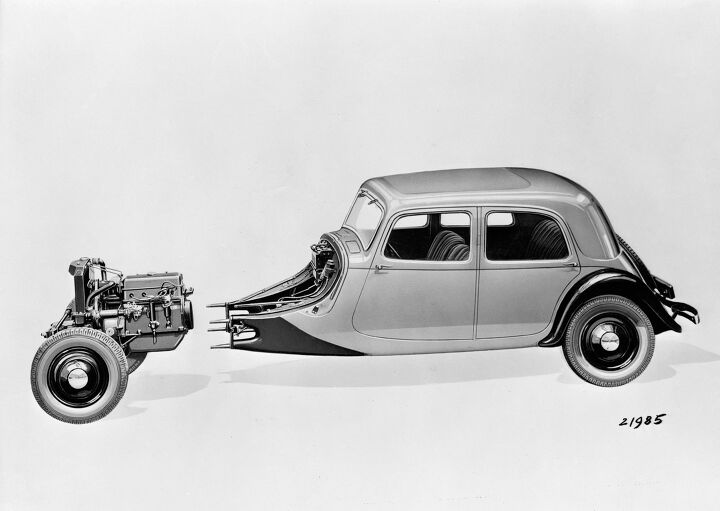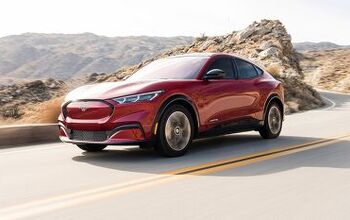Citron Traction Avant 11CV Commerciale - The World's First Hatchback?
The Volkswagen Golf GTi may be what many consider the definitive “hot hatch,” and most enthusiasts credit it with popularizing the idea of a functional yet fun-to-drive and economical daily driver. From its roots have sprung countless pocket-sized performance variants, right up to today’s current Focus RS.
But the Volkswagen Golf was far from the world’s first hatchback. It wasn’t even close.
So where did the idea of a hinged-rear body panel begin? More than 40 years prior to the launch of the GTi, another innovative car introduced the world to the idea of the hatchback, among a few other new features. Are you surprised that it was French, after our Matra article last month?
Until 1934, Citroën had produced cars much like every other manufacturer at the time: rear-drive, body-on-frame construction. But in 1934, the French company introduced a new concept with its Type 7A model. The drivetrain moved entirely to the front, with the 1303cc inline-four good for 32 horsepower powering the front wheels. The innovative change meant that there did not need to be a conventional transmission tunnel, or indeed any running gear behind the firewall.
As a result, Citroën abandoned the traditional body-on-frame design and utilized new all-steel unibody construction. Innovation on the 7A didn’t end there, as the car had independent torsion bar suspension, four-wheel hydraulic brakes and rubber motor mount technology licensed from Chrysler that Citroën called “Floating Motor.”
The name given to the 7A was “Traction Avant” — forward drive — to help differentiate it from the automaker’s normal rear-drive cars. Shortly after introduction in 1934, an enlarged version of the 7A — the 11A — was revealed. Some 5.5 inches longer and nearly eight inches wider than the 7, the new 11 had an upgraded 1911cc motor producing 46 hp. As with the 7, the 11 was initially available in Berline, Cabriolet, and Faux Cabriolet models. However, Citroën further stretched the wheelbase another eight inches to create the “Conduite Intérieure” and the “Familiale” models. Starting in 1936, the trunk was hinged on the bottom, granting access to the back from outside for the first time.
This bottom hinge formed part of what would become the next important step for the 11. In 1938, the 11 (now with CV suffix) model added to its lineup the “Commerciale” model. The major change was the addition of a hinged roof section that allowed access to the entire rear of the car. The lower portion containing the spare wheel, supported by large chains, swung downwards and formed a platform, while the window section folded upwards and out of the way of cargo.
Intended for craftsmen and families in need of moving cargo, Citroën marketed the extreme versatility of the 11CV with an advertisement campaign highlighting the many things which could be loaded into its new configuration. It didn’t matter if you were just trying to move some baguettes or if you were a butcher in need of transporting a few vache — the Commerciale was the hatchback for you!
Citroën arguably also created the world’s first crossover with its “Familiale” model. Built on the same lengthened chassis as the Commerciale, it featured a third row of convertible folding seats called strapontins. This gave the Familiale model a total passenger capacity of nine, though admittedly it wasn’t quite as spacious as a modern-day Suburban. The storable seats slotted into the middle of the passenger compartment, unlike the contemporary rear placement, thoroughly eliminating legroom for all.
Unfortunately for the firm, the outbreak of World War II signaled a new chapter in French history, instead of the triumph of the unique platform. As fuel shortages set in, companies such as F.A.P. Elgazo Tarbes created a coal-powered alternative that could be grafted onto the Traction Avant. Large “aerodynamic” coal containers flanked the front fenders, and when ignited they produced methane that could be run through a special carburetor. The unique solution to a problem that probably shouldn’t have existed gave you a 30-mile range on coal alone. Only a few of these 11 Gazogene models still exist, but you can visit one at the Lane Motor Museum.
As Citroën struggled to get its feet underneath it following the destruction of World War II, the 11CV Commeriale model continued with minor modifications. Now simply called the 11C, the most recognizable difference was that the lower portion of the hatch was incorporated into the upper portion. This formed a much more identifiable hatch, no longer with the spare wheel integrated.
The Traction Avant was a very dated design by that point, and the car was anything but a sales success, though it helped to keep the lights on until Citroën introduced its new — and equally forward-thinking — DS was ready for market in 1955. 11C production lasted through the end of the 1957 model year, with only a few thousand ultimately produced.
There would be other hatchbacks built in the 1950s, such as the Kaiser-Frazer Vagabond, but none really caught on until the 1960s. Based upon the basic formula of the 11C and the 2CV, rival Renault would go on to produce what many feel is the first “true” hatchback in 1961 with its model 4. Though not as innovative as the 7 and 11 models had been for Citroën, the Renault 4 would go on to sell in the millions as a lower cost, extremely versatile family hatchback, the success of which would create many copies in the 1970s and into the 1980s. The hot hatch era had arrived.
[Images and Sources: Citroën, Lane Motor Museum, Citroenet.org]
More by Carter Johnson
Latest Car Reviews
Read moreLatest Product Reviews
Read moreRecent Comments
- Jrhurren Legend
- Ltcmgm78 Imagine the feeling of fulfillment he must have when he looks upon all the improvements to the Corvette over time!
- ToolGuy "The car is the eye in my head and I have never spared money on it, no less, it is not new and is over 30 years old."• Translation please?(Theories: written by AI; written by an engineer lol)
- Ltcmgm78 It depends on whether or not the union is a help or a hindrance to the manufacturer and workers. A union isn't needed if the manufacturer takes care of its workers.
- Honda1 Unions were needed back in the early days, not needed know. There are plenty of rules and regulations and government agencies that keep companies in line. It's just a money grad and nothing more. Fain is a punk!












































Comments
Join the conversation
These show up in family photos taken for a few years in France starting in 1958. We found it very odd that such apparently old fashioned cars were still around. We kids referred to them as "gangster" cars. As I recall there were only black ones.
There were lots of these in Spain when I lived there in the late 1950s. They were in fact, about 7/8 of the size of other between-the-wars classics with the sweeping fenders, running boards, etc. 300 kg in the back is a pretty impressive payload. I remember riding around in these cars a few times; they were neat... at least to a 10-year old kid whose dad had a '57 Chevy. They were a very few DSs around. I remember seeing one flipped on a highway. The entire bottom of the car was covered in sheet metal. The only external piece was a dual exhaust and muffler. I thought they looked like frogs, coincidentally, a derisive term used by the English to refer to the French. Speaking about reliability in those days is really unfair . . . if you're imposing modern standards. Although my dad's Chevy ran 2 years in Spain on crappy roads and questionable gasoline without complaint or need for repair. In fact, he didn't trade it in until 1963, after we had returned to the U.S.